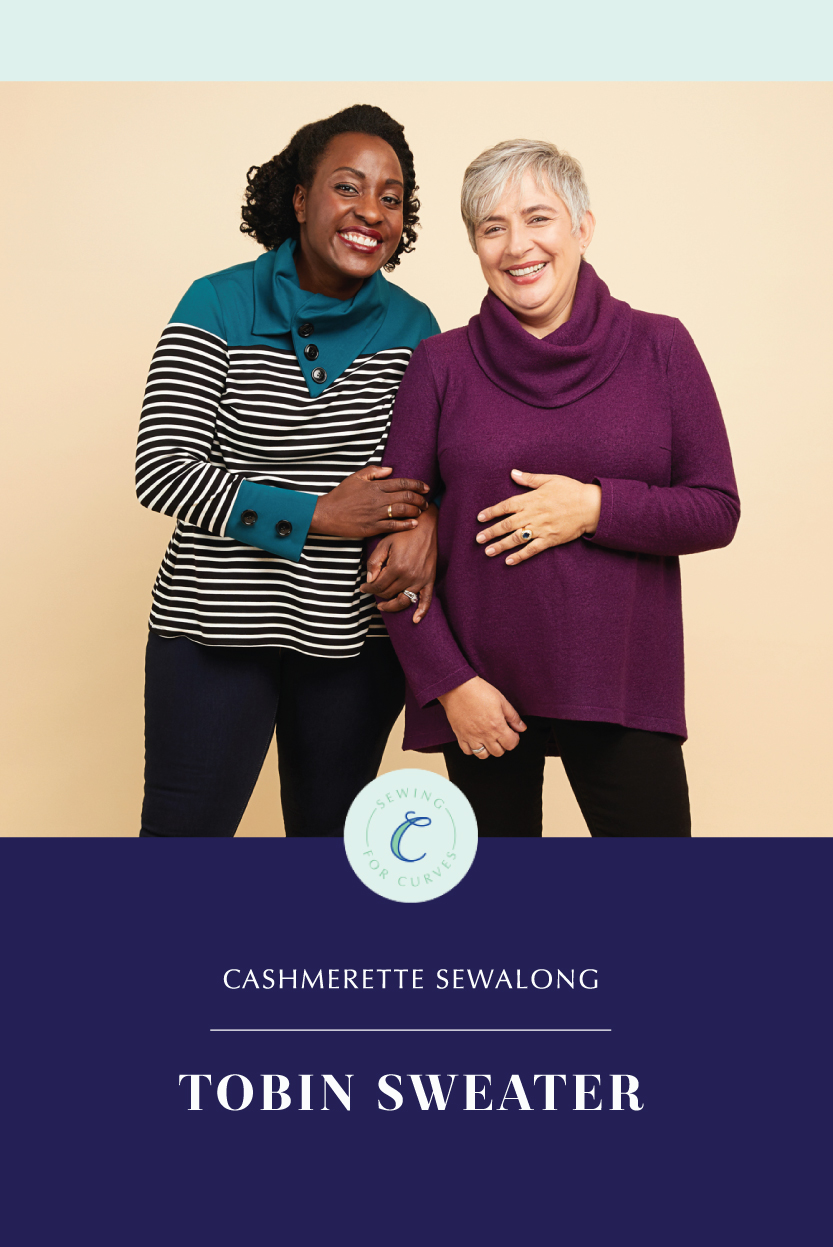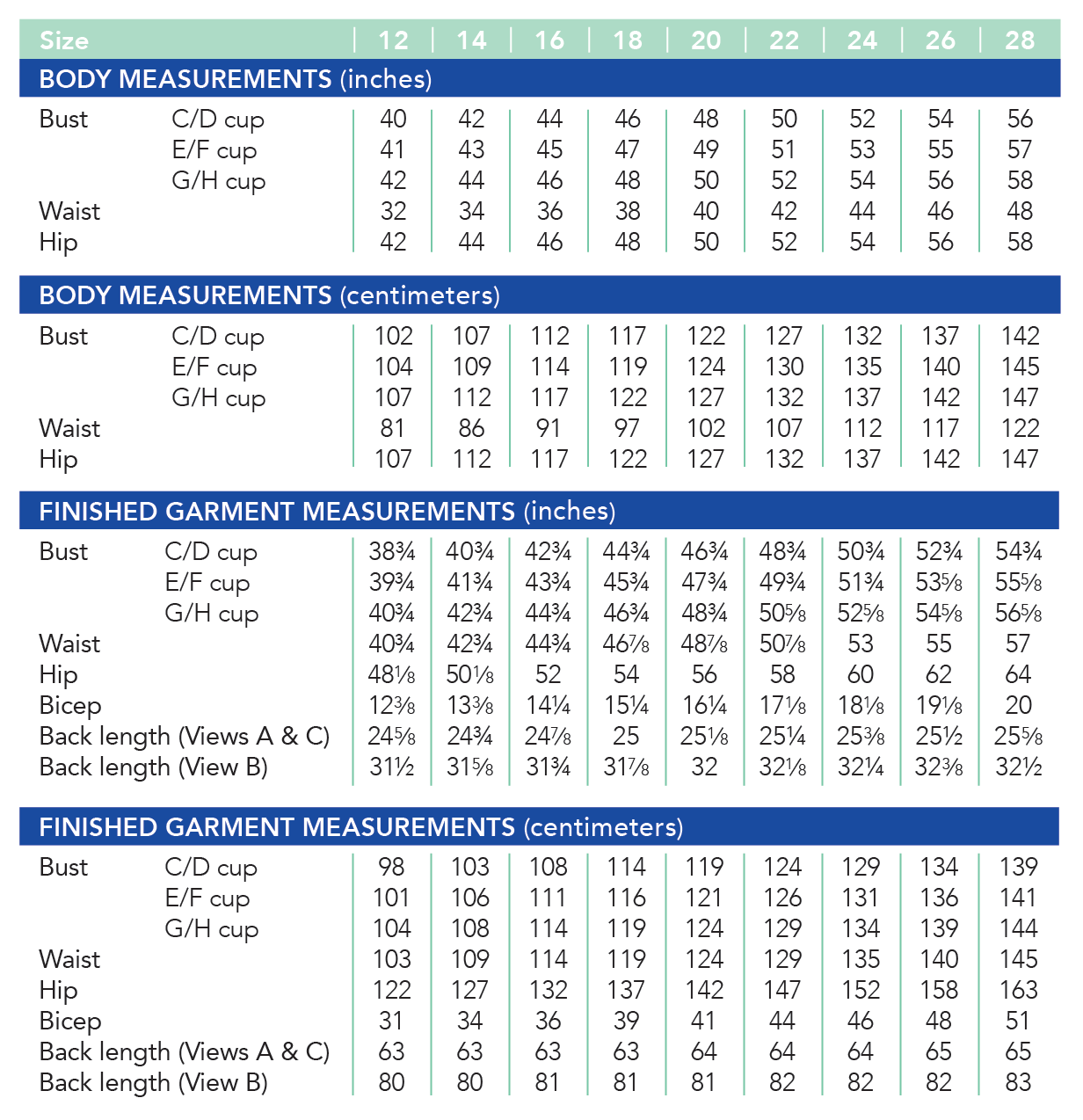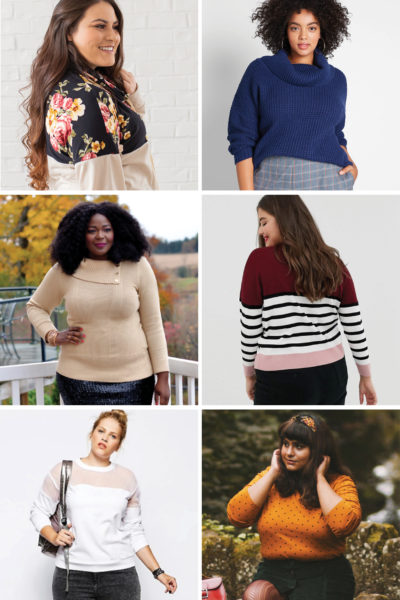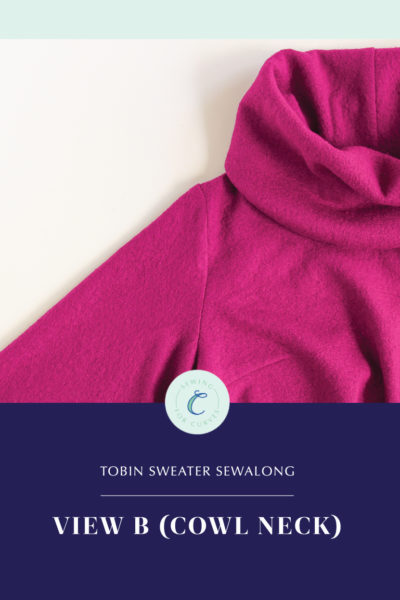When the weather is changing, a cozy sweater is a must-have layering piece. The Tobin Sweater will keep you warm all season long, and it’s designed specifically for curves, so you know you’ll get a great fit. We’re excited to kick off our Tobin Sweater sewalong where we show you how to sew a plus size sweater with step-by-step photos and tips and tricks along the way. Ready to get started?

There’s a few things we have to do before we sit down at our sewing machine, and that’s to prepare our pattern pieces and fabric. But maybe you’re not even there yet, and you need a little inspiration before deciding what your want your Tobin to look like—we got you covered with a whole lot of ideas from ready-to-wear fashion. Or maybe you’re not sure where to find sweater-appropriate fabric—we can help there too, with our sweater knit fabric ideas roundup! Plus, we’ve got five different Tobin Sweater fabric kits you can choose from for guaranteed coziness.
Okay, so we’ve got our pattern and fabric and are ready to go! First things first: we need to pick our size. Thanks to the three cup sizes it’s more likely that you’ll fit in a “straight” Cashmerette pattern than many other companies, but of course we all vary and chances are you may not be perfectly in one size. The good news is that sewing gives you tons of flexibility, and it’s easy to grade between sizes.
How to Choose Your Size
There are two measurement charts: one is the Body Measurement chart, and the other is the Finished Garment chart. The Body Measurement chart helps you choose your size based on what numbers you get when you measure your body with a tape measure—it has numbers for your bust (around the fullest part), waist and hip.
(Not sure how to measure yourself? We’ve got some helpful tips for finding your waist and why you should measure yourself when sitting.)
The Finished Garment chart shows you the size of the actual sewn garment. The difference between that and the Body Measurement chart is called “ease”, and it’s the amount of extra room or stretch in the garment that the designer recommends for the clothes to fit well and allow movement.
Generally, you want to start by comparing your measurement with the body measurement chart. However, if your measurements are between sizes you can take a look at the Finished Garment chart to see if you can fit in just one.

For the Tobin Sweater—as with all Cashmerette patterns—the best bet is to start with your bust measurement. You should use your full bust measurement, which is around the fullest part of your bust. Because of the cup sizing, you may find you could fit in two different bust sizes. In that case you want to pick the overall size that’s closest to your waist size. So for instance, if your bust is 44″, you could theoretically be a 14 G/H or a 16 C/D. Which one should you pick? Take a look at the waist measurement–if yours is closer to 34″ (size 14), then go with the 14 G/H. If yours is closer to 36″ (size 16), then go with the 16 C/D.
Don’t fret if the cup size doesn’t match up with your bra size–there is so much variation in bra sizing that it’s not possible to perfectly line them up. Use your actual full bust measurement and you’ll be fine.
Grading Between Sizes
If your bust, waist, and hip measurements end up in many different sizes, you may want to grade between sizes. There is a good bit of wearing ease in the waist and hips of the Tobin Sweater, so if your waist is less than a few inches bigger than the measurement according to your bust size, you don’t need to grade up unless you want more ease.
For a run-down of how to grade between sizes on pattern like the Tobin, check out this tutorial here.
Still not sure what size to use? You can write to us here for additional fitting advice, or consider signing up for the Cashmerette Fit Clinic!
Preparing Pattern and Fabric
Now that we’ve chosen our size and graded if necessary, it’s time to prepare our pattern and fabric so that we’ll be all ready to sew next time!
Here’s our fabric prep checklist:
- Wash and dry your fabric to make sure it’s pre-shrunk and you’re not going to get any nasty surprises later!
- Press your fabric so it’s nice and flat. Check to see if you get any iron shine when you press the right side. If so, you’ll want to use a press cloth when pressing between steps.
- If this is your first time making a Tobin, we recommend using an inexpensive fabric that has similar weight and stretch to your final fabric, in case further adjustments are needed.
And here’s what you need to do to prepare your pattern:
- If you’re using the PDF pattern and are printing your PDF pattern at home, you’ll need to print and assemble it. Here are some pointers to help you. If you want to get it printed, here are some suggestions.
- Either cut or trace off your pattern pieces. If you’re using a paper pattern, making adjustments, or are going to make any other sizes in the future, we definitely recommend tracing.
- If you’re sewing View B (the cowl neck version), you’ll need to assemble a few of the pattern pieces. Assemble the front and back pieces by cutting at the lines marked “Cut pattern piece here for View B” and taping the upper front (1 B) to the lower front (2 A/B/C) in your cup size and the upper back (3) to the lower back (4). Also tape the upper sleeve (9) to the lower sleeve (10).
- If you’re sewing View C (the sweatshirt version), assemble the sleeve piece by cutting at the lines marked “Cut pattern piece here for Views B & C” and tape the upper sleeve (9) to the lower sleeve (10).
- If you’re sewing View A (the split neck version), you’ll use all of the pattern pieces separately.
Finally, it’s time to cut into our fabric!
- Cut all pieces, following the layout diagrams in the pattern. Don’t forget to also cut the interfacing pieces if you’re sewing View C!
- Transfer all the markings to the fabric. For the notches, make a little snip into the fabric within the seam allowance (so no more than 1/4″ / 6mm).
Apply the Interfacing
We’re almost ready to sew! All that’s left to do is apply the interfacing if you’re sewing View C. On the wrong side of the following pieces, apply lightweight fusible interfacing following the manufacturer instructions to the front and back facing pieces.
Made it this far? Give yourself a pat on the back—the hard part is over and now comes the sewing! Check back later this week when we get started sewing our Tobins—you’ll be amazed at how quickly it comes together!
We want to see your creations, whatever stage of the process you’re at! Tag your makes with #TobinSweater on social media so we (and the whole sewing community) can cheer you on to the finish line!





Size 16 finished garment bust is smaller than actual bust size for CD. Is that a mistake?
Hi Rona,
There is negative ease in the bust in this pattern, so it’s by design! You can read all about negative ease here: https://blog.cashmerette.com/2019/02/what-is-negative-ease-and-how-does-it-work.html
-Ayelet at Cashmerette
I am excited to give this a try. On both the Concord and the Turner I have found that I benefit from a narrowing the neckline. Any guesses on weather I would likely want to make the same type of adjustment for this?
Hi Emily,
The neckline for the Tobin is fairly high, so you’re unlikely to need to narrow it. But it’s always good to try with a muslin first to check.
-Ayelet at Cashmerette
Can you share how to tell if the arms are going to fit? It looks like there is some negative ease but I can’t figure out if I need to do a full bicep adjustment. I’d probably make the 12 or 14 f/g but my arm measures just under 14”
Hi JB,
It depends on how stretchy your fabric is. If it’s on the stretchier side, you’ll be fine without a full bicep adjustment, but if it’s not very stretchy, you may find that it’s a little tight in the arms.
-Ayelet at Cashmerette